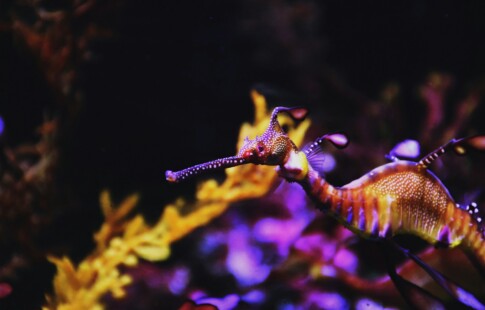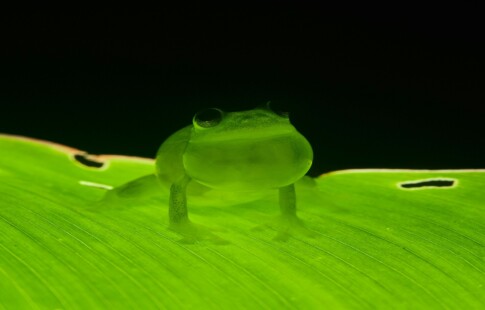
Tipping the Scales: What Will It Take to Eradicate Lionfish?
We are reader-supported. When you buy through links on our site, we may earn affiliate commission.
“Tigerfish” might have been a better name — the fish doesn’t quite resemble a lion. Gliding through the reefs with conspicuous orange and white stripes, a lionfish’s coloration sends a bold message: “I am toxic.” Its glistening rows of spines are framed in flowy, paper-thin wisps of floral fins, making the fish one of the most common aquarium species despite its difficult care requirements. How did this candystriped carnivore cause one of the worst ecological disasters to date?
Atlantic Invasion
No one knows how lionfish managed to colonize the Atlantic. Some say aquarium keepers threw the fish into the ocean when they realized how challenging they were to keep as pets, a problem Florida has also faced with pythons, tegus and peacocks. Now plaguing the coasts of the Carribean, Gulf of Mexico and Southeastern United States, the Indo-Pacific native first appeared in the 1980s in Florida. Since then, its populations have exploded.
There isn’t just one type of lionfish. The name refers to a genus containing several species, with Pterois volitans and Pterois miles being invasive in the Western Hemisphere. But most people don’t make that distinction — lionfish look very similar to one another. And, most importantly, they all share the same infamous behavior.
Lionfish are voracious carnivores. True generalists, they’re prone to eat practically any animal small enough to fit in their mouths, sucking their prey in whole. They employ a unique hunting technique that involves shooting a water jet to stun their victims. They then vacuum them up in such a swift motion that scientists had to use slow-mo to understand it.
The effects on local ecosystems are devastating. In just a two-year period in the Bahamas, lionfish caused a 65% decline in the prey population. When lionfish target herbivorous parrotfish, seaweed and algae begin growing out of control. Perhaps the worst insult is that lionfish tend to live along already-struggling reef ecosystems.
Few predators will eat lionfish due to their venomous spines. And because Atlantic prey animals didn’t evolve alongside lionfish, they lack any natural fear of the bold hunters. Frustratingly, prey species will often let lionfish approach and eat them without reacting, even if the predators have already eaten several other animals nearby.
This phenomenon is called prey naiveté. In the same phenomenon by which domestic cats kill native reptiles, prey animals faced with a novel predator don’t seem to know, instinctively, to be afraid. The lionfish seem to be aware of their invisible-to-prey-animals status — they breeze through the reefs with a cocky machismo, picking off small fishes, crabs and squid with a nonchalance that almost seems cartoonish.
Another reason for their invasive status? Lionfish reproduce like rabbits.
A single female can release 10,000 to 40,000 eggs every four days, making it virtually impossible to kill every individual. Many of these invasive carnivores live in depths just out of reach of most divers. And then, there are the spines.
Lionfish possess 18 venomous quills that inflict an excruciating sting, leading to sweating, swelling, respiratory distress and even paralysis. Their toxicity makes the fish risky to approach, so divers have to use spear guns and special containers to harvest them safely.
All of these factors have made the lionfish the poster child of aquatic invasive species. So, what can we do to stop them?
Stemming the Tide
Lionfish are probably here to stay. But, people are taking steps to reduce their numbers so they don’t decimate reef ecosystems.
1. If You Can’t Beat Them, Eat Them
Unlike fish that have toxic flesh or organs, lionfish venom is only found in the species’ conspicuous spines. Once you remove these offending barbs, the fish is safe to prepare and enjoy, and has a soft, flaky texture with a buttery taste.
The National Oceanic and Atmospheric Administration (NOAA) actively encourages people to eat the invasive species. By promoting lionfish to restaurants, the NOAA has persuaded hungry diners to take part in wildlife conservation. In Colombia, Catholic priests even swayed their congregations to eat the fish during Lent, touting the act as a good deed that still aligned with the rules of not eating other types of meat.
Critics of the practice claim that creating a market for lionfish incentivizes economies to keep the fish alive. In response, opponents cite the fate of the passenger pigeon — since when did uncontrolled hunting ever benefit a species? Regardless of the final outcome, promoting lionfish cuisine will at least help to manage their populations.
2. Friendly Competition
After the sun, lionfish derbies are the hottest thing in Florida right now. The Reef Environmental Education Foundation (REEF) and Florida Keys National Marine Sanctuary host annual contests challenging divers to kill as many lionfish as possible. They award special prizes for the largest, smallest and most lionfish harvested.
The competition serves an important environmental purpose. Incentivizing lionfish hunts makes people more prone to take action, and it also spreads awareness about the invasive species. Plus, festival-goers get to dine on lionfish. It’s a win-win.
3. Killer Robots
It may sound like a bad sci-fi premise, but some scientists think the best hope of defeating the lionfish horde is with unmanned underwater robots. Autonomous marine vehicles can prowl the seas with a speargun or electric prod, using AI to detect and dispatch lionfish on sight.
Robots in Service of the Environment (RSE) is already on their third generation lionfish-hunting machine. It zaps the unsuspecting fish to incapacitate them, then sucks them into a container for capture. Once the container is full, it returns to the surface where scientists can study the fish. The best part about underwater vehicles is that they can go deeper than a diver, reaching the untouched pockets of lionfish dwelling just out of reach.
If enough robots are deployed, there’s a solid chance that lionfish will go the way of the silver trout — fished until they finally disappear.
Lions of the Deep
Eventually, control efforts may put a sizeable dent in lionfish populations. By using autonomous underwater vehicles, hosting spearfishing contests and putting lionfish on the menu at more restaurants, the fish’s carnivorous reign may one day come to an end.
Until then, however, lionfish are the Atlantic Ocean’s saltiest sea dogs, earning their place as one of the most successful invasive predators of all time. Maybe their name really does fit.
Share on
Like what you read? Join other Environment.co readers!
Get the latest updates on our planet by subscribing to the Environment.co newsletter!
About the author

Steve Russell
Steve is the Managing Editor of Environment.co and regularly contributes articles related to wildlife, biodiversity, and recycling. His passions include wildlife photography and bird watching.





